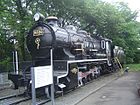JNR Class 9600
1,067 mm (3 ft 6 in) (JNR Class 9600, Taiwan Railways Administration DT580 Class)
1,435 mm (4 ft 8+1⁄2 in) (Chinese Railways KD5)
| Performance figures | |
|---|---|
| Maximum speed | 65 km/h (40 mph) |
| Career | |
|---|---|
| Locale | All of Japan, except Shikoku |
| Retired | 1976 |
| Disposition | 43 preserved, remainder scrapped |
The Class 9600 (9600形) is a type of 2-8-0 steam locomotive built by Japanese Government Railways (JGR, after-day Japanese National Railways (JNR)) from 1913. The Class 9600 was the first type of locomotive to be mass-produced by Japanese manufacturers. The Class 9600 were popularly known as Kyuroku (nine-six), and were extensively used for freight service throughout Japan.[1]
They were numbered 9600-9699, 19600-19699, 29600-29699, 39600-39699, 49600-49699, 59600-59699, 69600-69699 and 79600-79669. All 770 remained in service[citation needed] until the 2nd of March 1976, when all steam-hauled service on JNR's network has been phased out.[2]
Service outside Japan
Taiwan Railways Administration DT580
From 1923 to 1939, Kawasaki, Kisha Seizō, Nippon Sharyō, and Hitachi built 39 9600s for the Government General of Taiwan. The Taiwan Government Railway classified them 800 class before 1937, and they were classified D98 after 1937. After World War II, they were taken over by Taiwan Railways Administration, and they were classified DT580. One engine, DT619, is being rebuilt by combining parts of scrapped locomotives after the war.
China Railway class KD5/KD55
To alleviate a severe motive power shortage on the Central China Railway, JNR locomotives were converted from Japanese narrow gauge to standard gauge and shipped to China. 251 Class 9600 locomotives were sent for use on both the Central China Railway and the North China Transportation Company (NCTC class ソリコ (Soriko)); after the Pacific War, these became China Railway class KD5. Others were rebuilt to metre gauge for operation on Yunnan's Kunming–Hekou Railway and its branches; these eventually became China Railway class KD55.[3]
Preserved examples
As of April 2024[update], 43 Class 9600 locomotives are preserved at various locations in Japan.[4] There had previously been more locomotives of the class preserved across the country, however the number of which had started drastically decreasing over the following years due to multiple allegations and negligent practices towards historic preserved steam locomotives in Japan.
Number 39685, built in 1920, has been preserved outdoors in Chuo-ku, Saitama since 1972, but was removed and cut up in September 2016 due to the prohibitive cost of restoration.[5]
Number 29657, built in 1919, had been preserved and used for the Morimon Onsen SL Land hotel in the Niigata Prefecture of Uonuma City in 1979. But in 1998, the SL Hotel business was discontinued and the engine and its consist were left as an outdoor static display artifact for the public to view upclose. Though in 2015, it was abandoned after the Morimon Onsen Seiunkan closed in March of that same year. One of the two passenger carriages that was used for the hotel was removed sometime before or during 2014. In 2022, however, the 29657 and the last coach were unceremoniously scrapped on-site years later. To this day, it is not known why the city didn't bother to sell or donate the locomotive and carriage to anyone else, or to a railway museum willing to have them fully restored, after the Morimon Onsen Seiunkan shut down years before.
Recently as of April 22nd, 2024, number 19633, built in 1917, which was previously on display outdoors near the Wakamatsu Station in the Fukuoka Prefecture, Kitakyushu City, since 1989, which was allegedly reported to have been bought and thought to have been moved to its new location in 2020 near the Yamaguchi Yuya Fukutaro food corporation in Soeda Town, was scrapped after being left exposed to the weather elements, deteriorating, and neglected for many years without much cosmetic maintenance.
- 9608 preserved at Ome Railway Park
-
 39685 preserved in Saitama
39685 preserved in Saitama - 49643 preserved in Abashiri, Hokkaido
- 59601 preserved in Nayoro, Hokkaido
- KD55-579 preserved at the China Railway Museum
- KD5-373 preserved at the China Railway Museum
-
 DT609, one of 39 locomotives of the DT580 Class (based on the 9600 Class steam locomotives from Japan) preserved in Kaohsiung, Taiwan
DT609, one of 39 locomotives of the DT580 Class (based on the 9600 Class steam locomotives from Japan) preserved in Kaohsiung, Taiwan
See also
- Japan Railways locomotive numbering and classification
- JNR Class D50
- JNR Class D51
- JNR Class D52
- JNR Class D60
- JNR Class D61
- JNR Class D62
References
- ^ a b Naotaka Hirota Steam Locomotives of Japan (1972) Kodansha International Ltd. pp.54&95 ISBN 0-87011-185-X
- ^ "【今日は何の日?】蒸気機関車の日常的な使用が終了". Traffic News. 2021-03-02. Retrieved 2021-03-02.
- ^ 中国蒸汽機車世紀集影 (Centennial Collection of Chinese Steam Locomotives), China Railway Publishing House, July 2001, ISBN 7-113-04148-5 (in Chinese)
- ^ Sasada, Masahiro (25 November 2014). 国鉄&JR保存車大全2015-2016 [JNR & JR Preserved Rolling Stock Complete Guide 2015-2016] (in Japanese). Tokyo, Japan: Ikaros Publications Ltd. pp. 72, 126–127. ISBN 978-4863209282.
- ^ さいたま市の39685号機が解体へ [39685 in Saitama to be cut up]. Japan Railfan Magazine Online (in Japanese). Japan: Koyusha Co., Ltd. 12 September 2016. Archived from the original on 12 September 2016. Retrieved 12 September 2016.

- v
- t
- e
 Japanese Government Railway Steam Locomotives
Japanese Government Railway Steam Locomotives| Four-driver | |
|---|---|
| Six-driver |
|
| Ten-driver |
| Four-driver |
|
|---|---|
| Six-driver | |
| Eight-driver | |
| Ten-driver |
|
| Mallet |
|
| Four-driver |
|
|---|---|
| Six-driver |
|





















